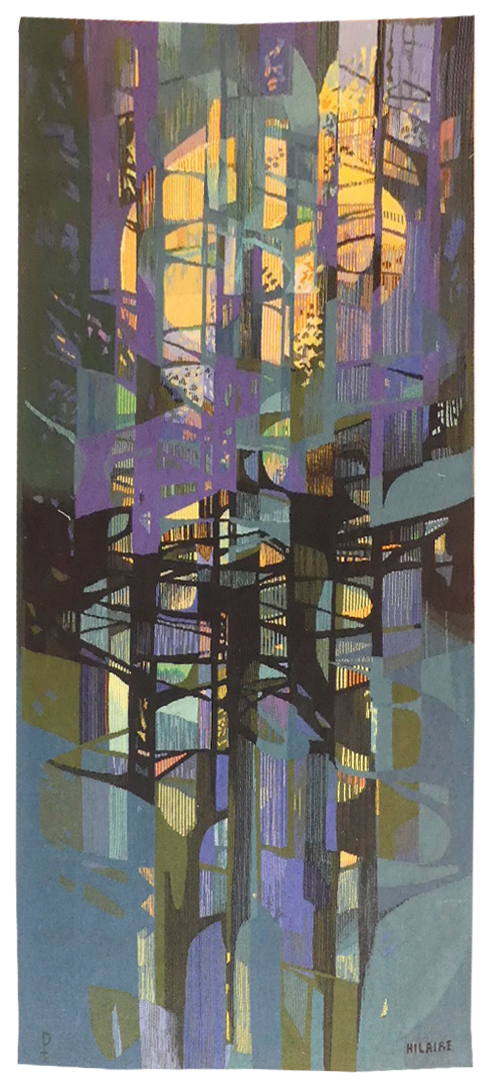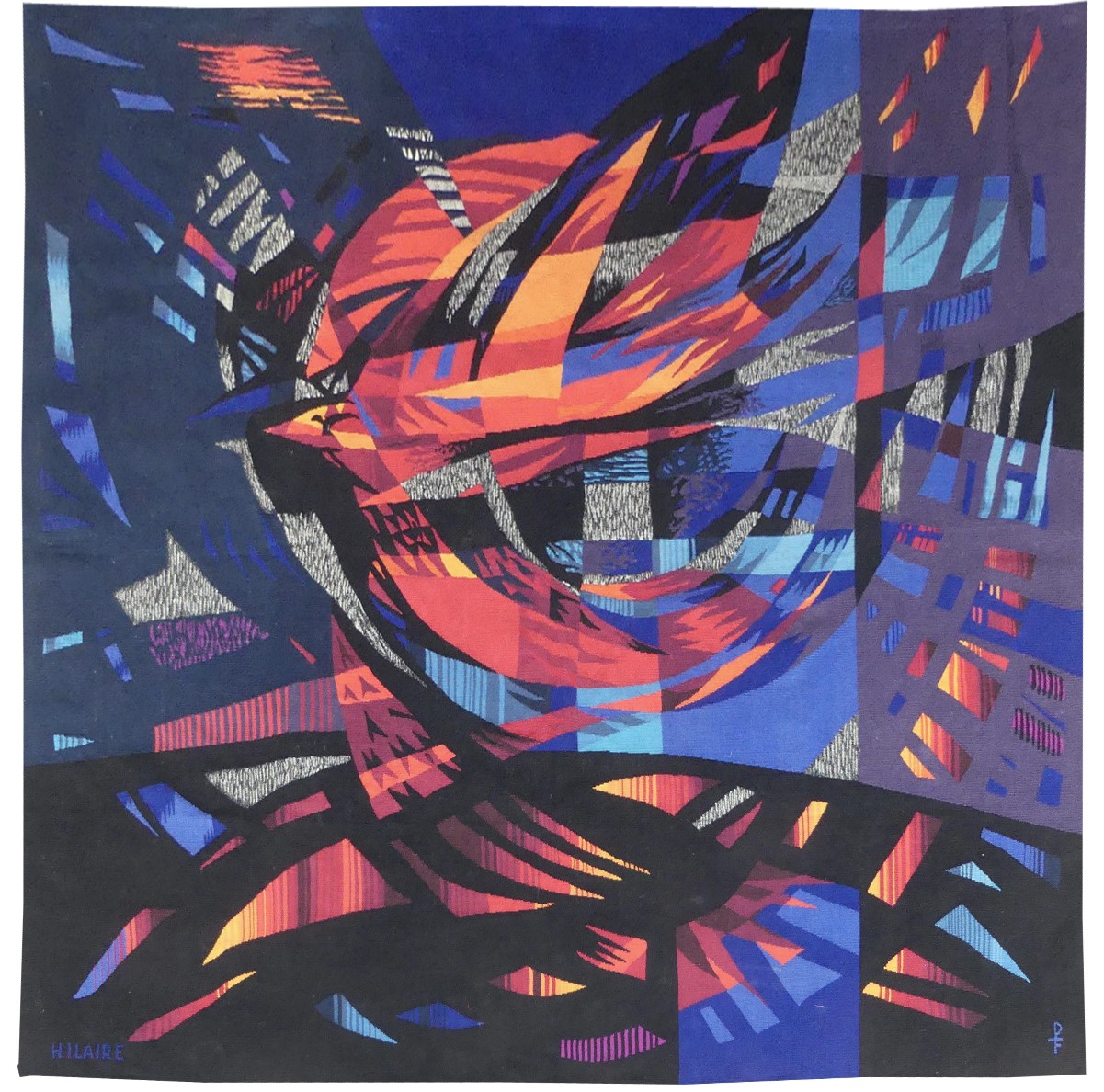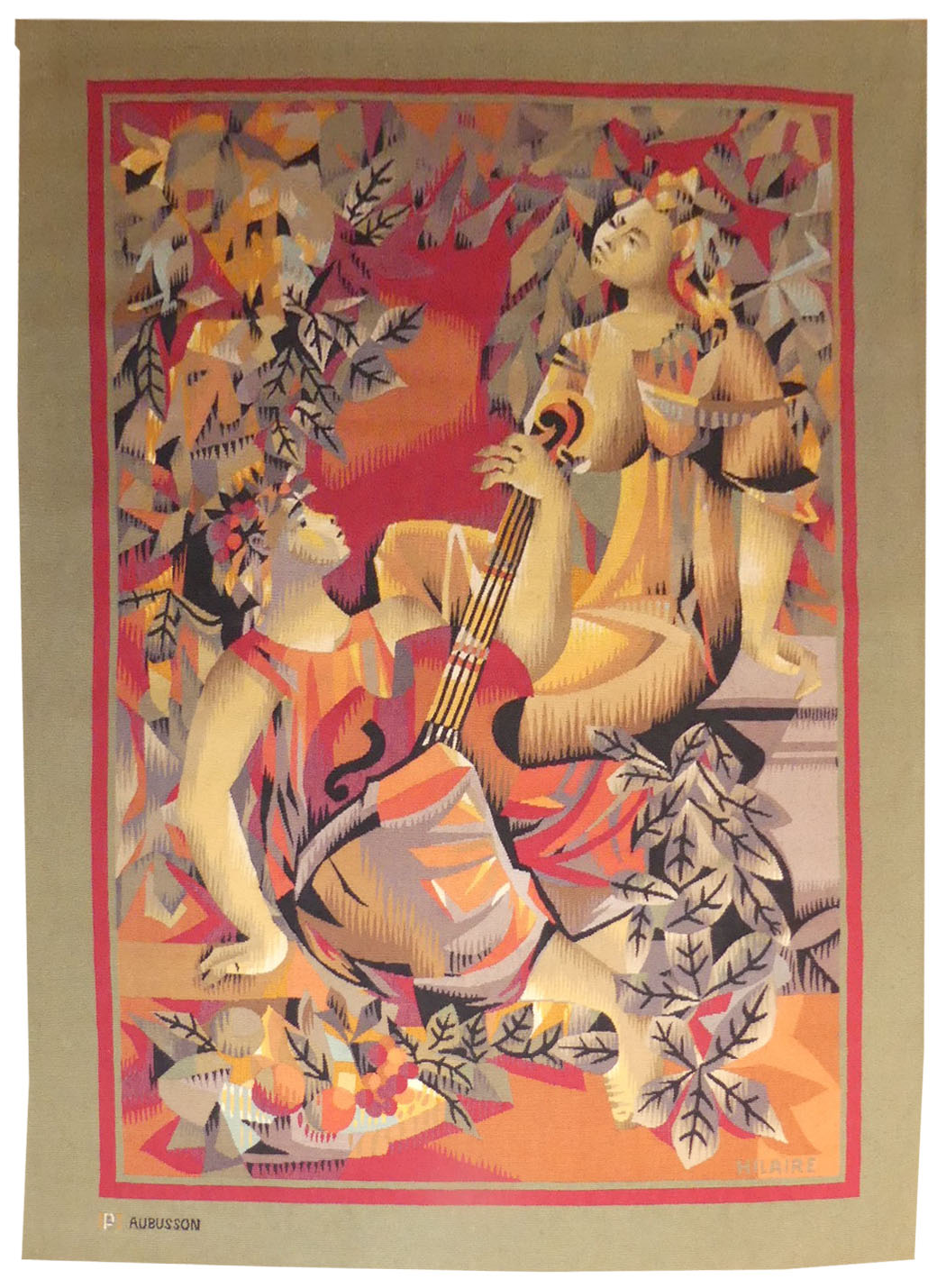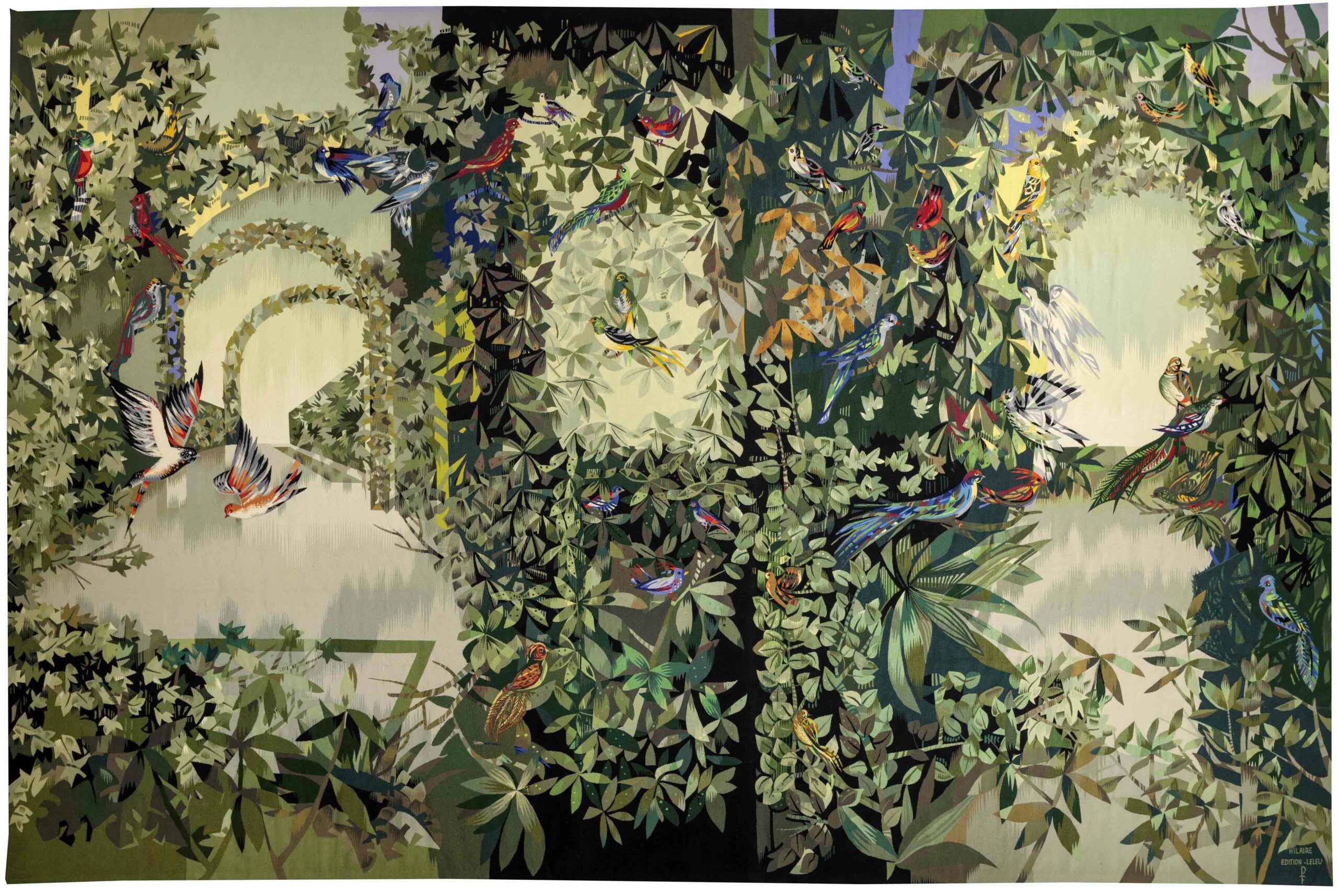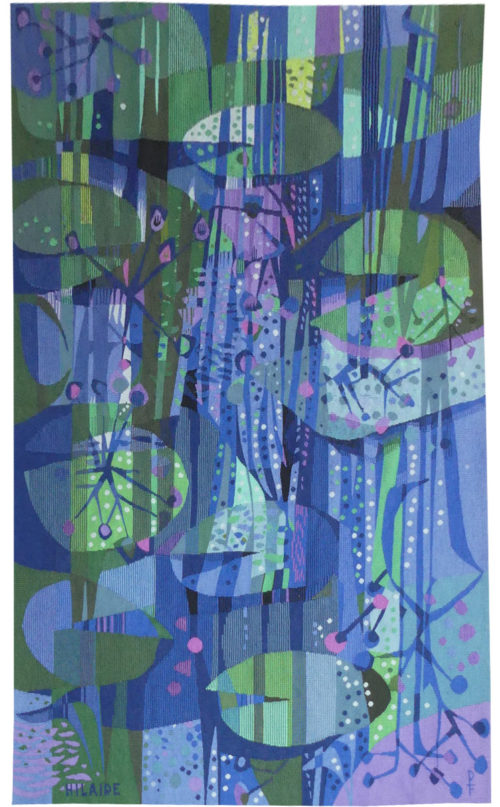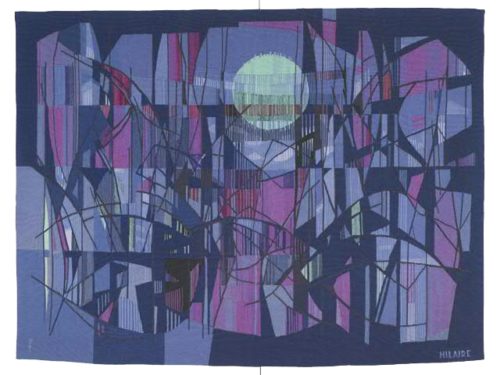-
L’oiseau de feu (the firebird)
Aubusson tapestry woven in the Pinton workshop. With signed label. 1963. With a taste for the large-scale, influenced by Untersteller at the Ecole des Beaux Arts, Hilaire undertook numerous mural paintings. In the same vein, beginning in 1949, along with a number of other artists stimulated by Lurçat, (he would join the latter at the A.P.C.T. Association des Peintres-Cartonniers de Tapisserie) he designed a number of cartoons some of which were woven at Beauvais or at Les Gobelins. “L’oiseau de feu » is a rare example of the dynamic in works by Hilaire who has accustomed us to more static subjects like hothouses and forest scenes : his rather fragmentary and kaleidoscopic style is however admirably suited to conveying the idea of movement. Bibliography : Exhibition catalogue Hilaire, œuvre tissé, galerie Verrière, 1970, ill. Exhibition catalogue, du trait à la lumière, Musée Départemental Georges de la Tour, Vic-sur-Seille, 2010. -
Sérénade
Aubusson tapestry woven in the Pinton workshop. Circa 1950. With a taste for the large-scale, influenced by Untersteller at the Ecole des Beaux Arts, Hilaire undertook numerous mural paintings. In the same vein, beginning in 1949, along with a number of other artists stimulated by Lurçat, (he would join the latter at the A.P.C.T. Association des Peintres-Cartonniers de Tapisserie) he designed a number of cartoons some of which were woven at Beauvais or at Les Gobelins. This tapestry is probably one of Hilaire’s first cartoons for the medium, at a period in his work when the human figure was still omnipresent (before disappearing completely around 1960), and he was being regularly commissioned for works in public spaces : this bucolic « Serenade » can be seen to refer to « Quatuor » a cartoon dating from 1950 and woven by Pinton for the Mobilier National. Bibliography : Exhibition catalogue Hilaire, œuvre tissé, galerie Verrière, 1970 Exhibition catalogue, du trait à la lumière, Musée Départemental Georges de la Tour at Vic-sur-Seille, 2010. -
Aubusson tapestry woven in the Pinton workshop for Leleu. With label. 1964.With a taste for the large-scale, influenced by Untersteller at the Ecole des Beaux Arts, Hilaire undertook numerous mural paintings. In the same vein, beginning in 1949, along with a number of other artists stimulated by Lurçat, (he would join the latter at the A.P.C.T. Association des Peintres-Cartonniers de Tapisserie) he designed a number of cartoons some of which were woven at Beauvais or at Les Gobelins. This tapestry hung in the dining-room of the villa Médy Roc, at the Cap d’Antibes, for which the Leleu studio designed furnishings and fittings starting in 1957 : their philosophy, inspired by Jacques Adnet’s theories of the interweaving of architecture, furniture and tapestry design , which should all be unified by a single view, was to lean into the idea of a tradition of good taste “à la française”, as interpreted by the best designers and artists of the period. With this in mind, another work, also by Hilaire, “Jardin à la française” was already in place in the dining-room before this tapestry, where a traditional trellis shelters birds of more exotic plumage, was installed in the same area in 1964. Both works appear in the film “Les seins de glace”, directed by Lautner featuring Delon, Brasseur and Mireille Darc, which was filmed on location in the villa. Provenance : villa Médy Roc, Cap d’Antibes Bibliography : Exhibition catalogue Hilaire, œuvre tissé, galerie Verrière, 1970 Exhibition catalogue, du trait à la lumière, Musée Départemental Georges de la Tour at Vic-sur-Seille, 2010.
-
Les nymphéas (the waterlilies)
Aubusson tapestry woven in the Pinton workshop for the Verrière gallery. With label, n°4/6. 1968.With a taste for the large-scale, influenced by Untersteller at the Ecole des Beaux Arts, Hilaire undertook numerous mural paintings. In the same vein, beginning in 1949, along with a number of other artists stimulated by Lurçat, (he would join the latter at the A.P.C.T. Association des Peintres-Cartonniers de Tapisserie) he designed a number of cartoons some of which were woven at Beauvais or at Les Gobelins. Hilaire makes the subject, previously referenced by Monet, his own in his habitual, cubist (and tending towards the abstract) style, characterised by lines and circular shapes in an exalted blue and green colour scheme. His early passion for horticulture, which was originally to be his profession, here echoes that of Monet in Giverny. Bibliography : Exhibition catalogue Hilaire, œuvre tissé, galerie Verrière, 1970, ill. Exhibition catalogue, du trait à la lumière, Musée Départemental Georges de la Tour at Vic-sur-Seille, 2010. -
Camargue
Aubusson tapestry woven in the Pinton workshop. Complete with certificate of origin signed by the artist n° 4 of 6. 1963. With a taste for the large-scale, influenced by Untersteller at the Ecole des Beaux Arts, Hilaire undertook numerous mural paintings. In the same vein, beginning in 1949, along with a number of other artists stimulated by Lurçat, (he would join the latter at the A.P.C.T. Association des Peintres-Cartonniers de Tapisserie) he designed a number of cartoons some of which were woven at Beauvais or at Les Gobelins. His figurative cubist-influenced style (which sometimes approaches abstraction) is immediately recognisable in his tapestry cartoons : in this one, but also for example in the one designed for the Salon Fontainebleau for the ocean liner France, “Sous-bois” (undergrowth) (190 x 988 cm, Pinton frères, reproduced in Le paquebot France, Armelle Bouchet Mazas, Paris 2006p. 169) where shapes and colours are fragmented in a kaleidoscopic fashion. “Camargue” is reproduced in the “Tapisserie d’Aubusson” sample collection of the Guéret Chamber of Commerce and Industry published in the early 1980’s to illstrate the technical competence of the Aubusson workshops. Bibliography : Exhibition catalogue Hilaire, œuvre tissé, galerie Verrière, 1970 (ill.) Exhibition catalogue, du trait à la lumière, Musée Départemental Georges de la Tour at Vic-sur-Seille, 2010.


